No CrossRef data available.
Article contents
Decoding variance and predictive ability in selection systems: an application of Gauthier’s framework of rater cognitions
Published online by Cambridge University Press: 27 August 2024
Abstract
An abstract is not available for this content so a preview has been provided. Please use the Get access link above for information on how to access this content.

- Type
- Commentaries
- Information
- Copyright
- © The Author(s), 2024. Published by Cambridge University Press on behalf of Society for Industrial and Organizational Psychology
References
DeNisi, A. S., & Murphy, K. R. (2017). Performance appraisal and performance management: 100 years of progress? Journal of Applied Psychology, 102(3), 421–433. https://doi.org/10.1037/apl0000085
CrossRefGoogle ScholarPubMed
Foster, J., Steel, P., Harms, P., O’Neill, T., & Wood, D. (2024). Selection tests work better than we think they do and have for years. Industrial and Organizational Psychology Journal, 17.Google Scholar
Gauthier, G., St-Onge, C., & Tavares, W. (2016). Rater cognition: review and integration of research findings. Medical Education, 50(5), 511–522. https://doi.org/10.1111/medu.12973
CrossRefGoogle ScholarPubMed
Gingerich, A., Regehr, G., & Eva, K. W. (2011). Rater-based assessments as social judgments: Rethinking the etiology of rater errors. Academic Medicine, 86, 1–7. https://doi.org/10.1097/acm.0b013e31822a6cf8.CrossRefGoogle ScholarPubMed
Gingerich, A., Schokking, E., & Yeates, P. (2018). Comparatively salient: Examining the influence of preceding performances on assessors’ focus and interpretations in written assessment comments. Advances in Health Sciences Education, 23(5), 937–959. https://doi.org/10.1007/s10459-018-9841-2
CrossRefGoogle ScholarPubMed
Harari, M. B., Rudolph, C. W., & Laginess, A. J. (2014b). Does rater personality matter? A meta-analysis of rater big five-performance rating relationships. Journal of Occupational and Organizational Psychology, 88(2), 387–414. https://doi.org/10.1111/joop.12086
CrossRefGoogle Scholar
Lewis, H. A. (2021). A study to identify factors of rater cognition from different rater perspectives during performance-based assessments. University of Kansas ProQuest Dissertations Publishing.Google Scholar
Mishra, V., & Roch, S. G. (2013). Cultural values and performance appraisal: Assessing the effects of rater self-construal on performance ratings. Journal of Psychology, 147(4), 325–344. https://doi.org/10.1080/00223980.2012.694377
CrossRefGoogle ScholarPubMed
Scullen, S. E., Mount, M. K., & Goff, M. (2000). Understanding the latent structure of job performance ratings. Journal of Applied Psychology, 85, 956–970.CrossRefGoogle ScholarPubMed
Sebok, S. S., & Syer, M. D. (2015). Seeing things differently or seeing different things? Exploring raters’ associations of noncognitive attributes. Academic Medicine, 90, 1–6. https://doi.org/10.1097/acm.0000000000000902.CrossRefGoogle ScholarPubMed
Spence, J. R., & Keeping, L. (2011). Conscious rating distortion in performance appraisal: A review, commentary, and proposed framework for research. Human Resource Management Review, 21(2), 85–95. https://doi.org/10.1016/j.hrmr.2010.09.013
CrossRefGoogle Scholar




